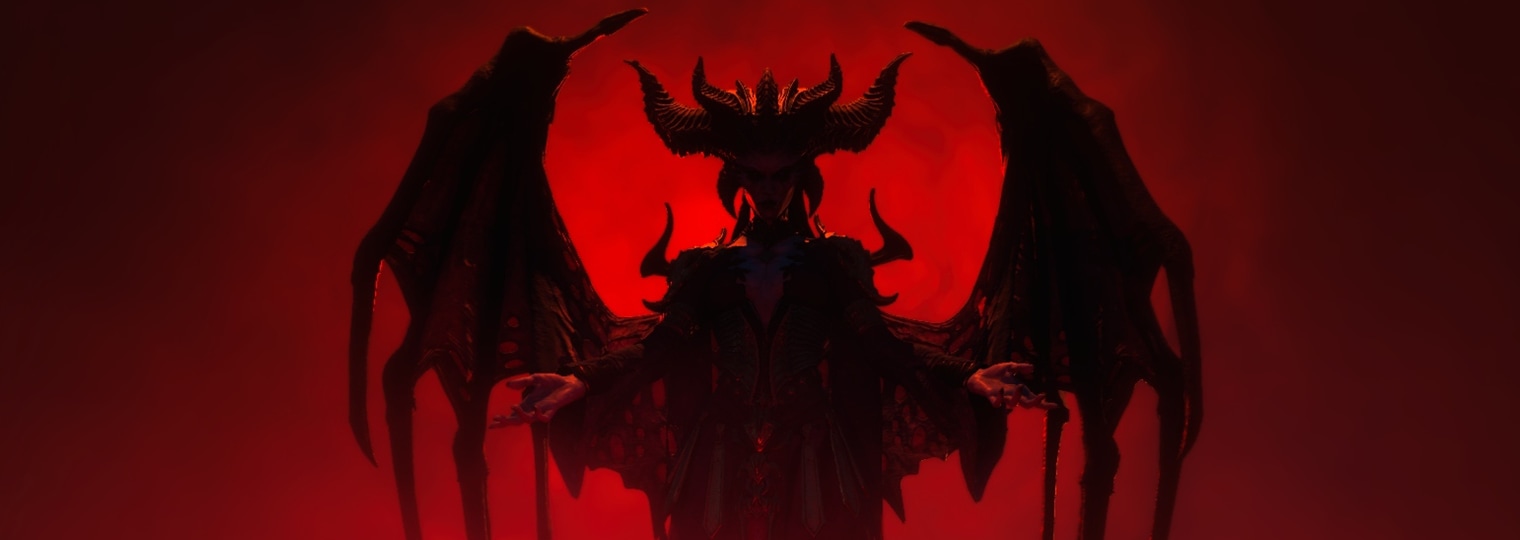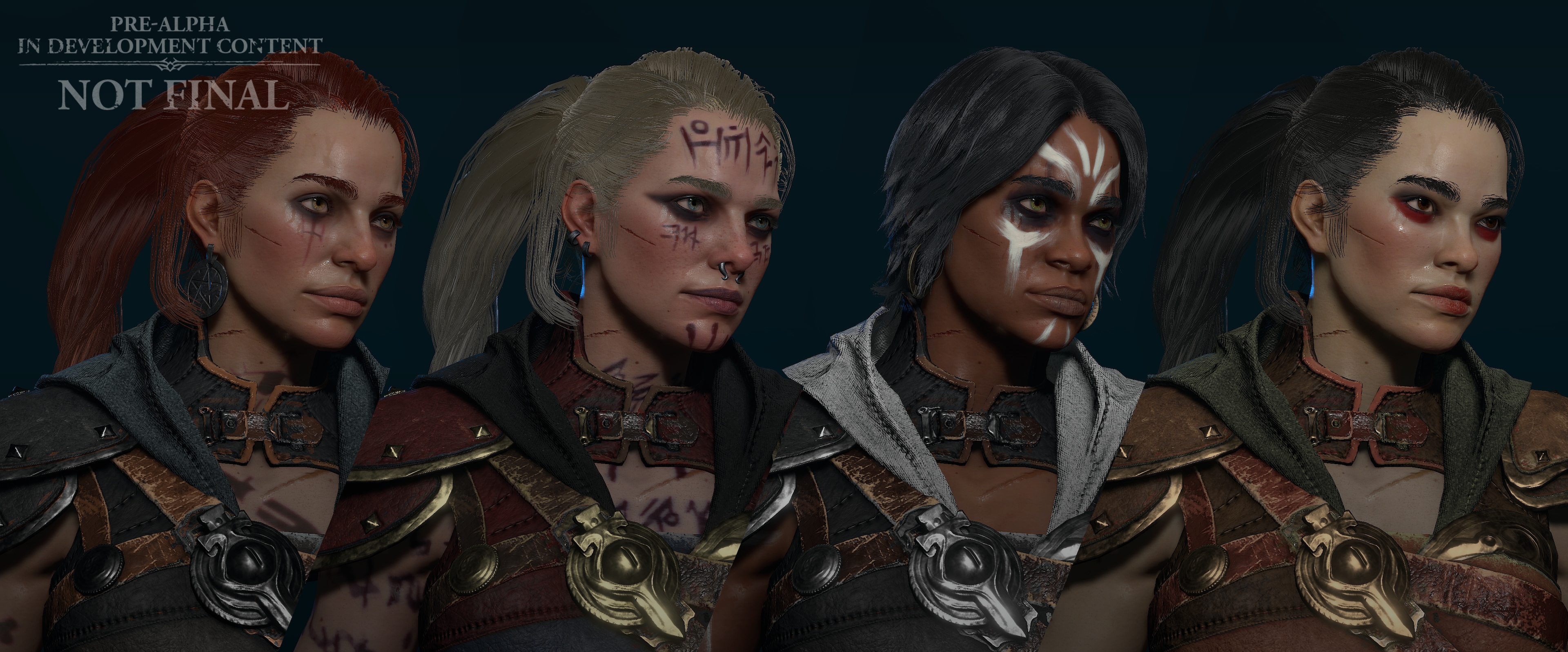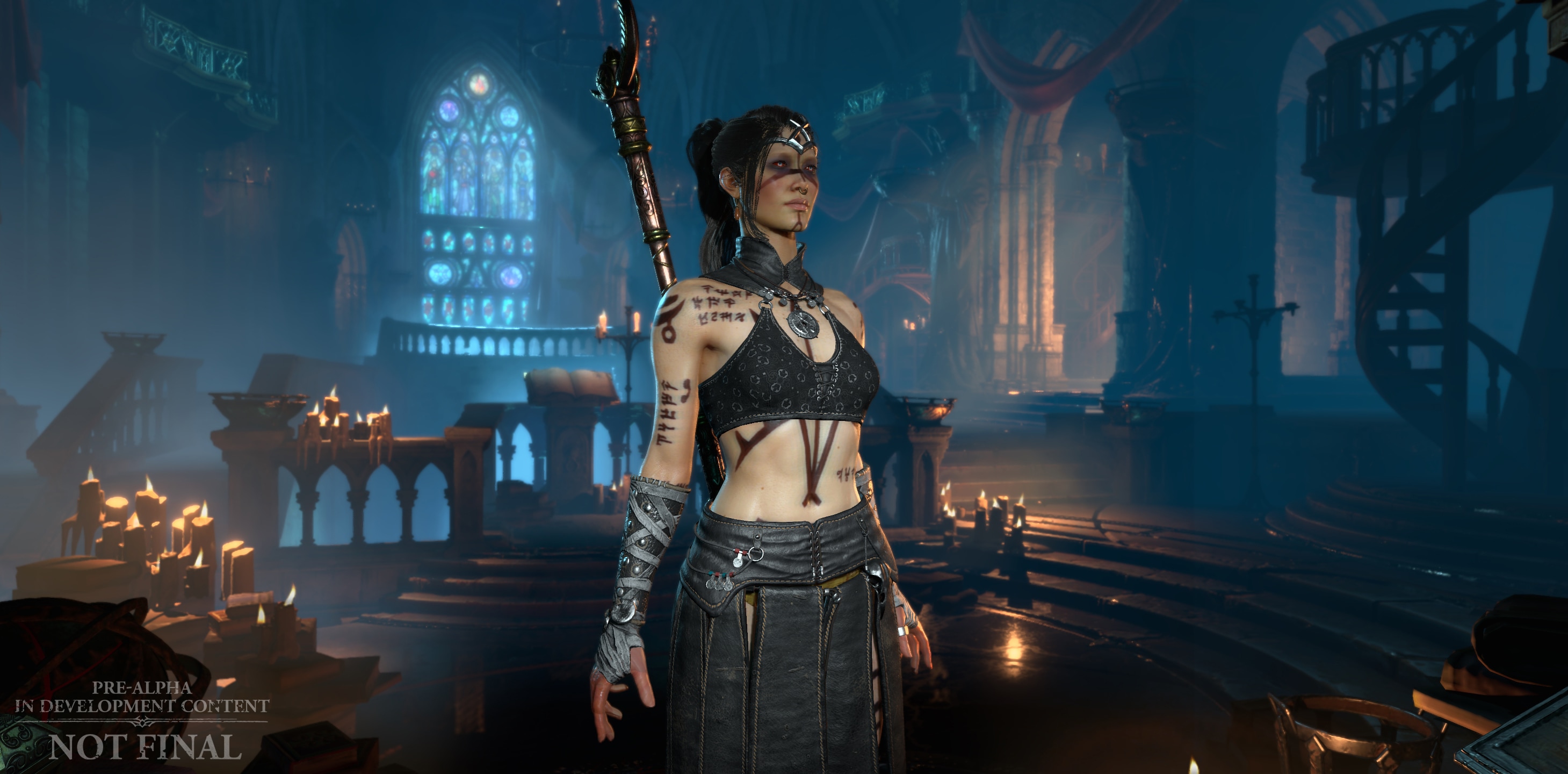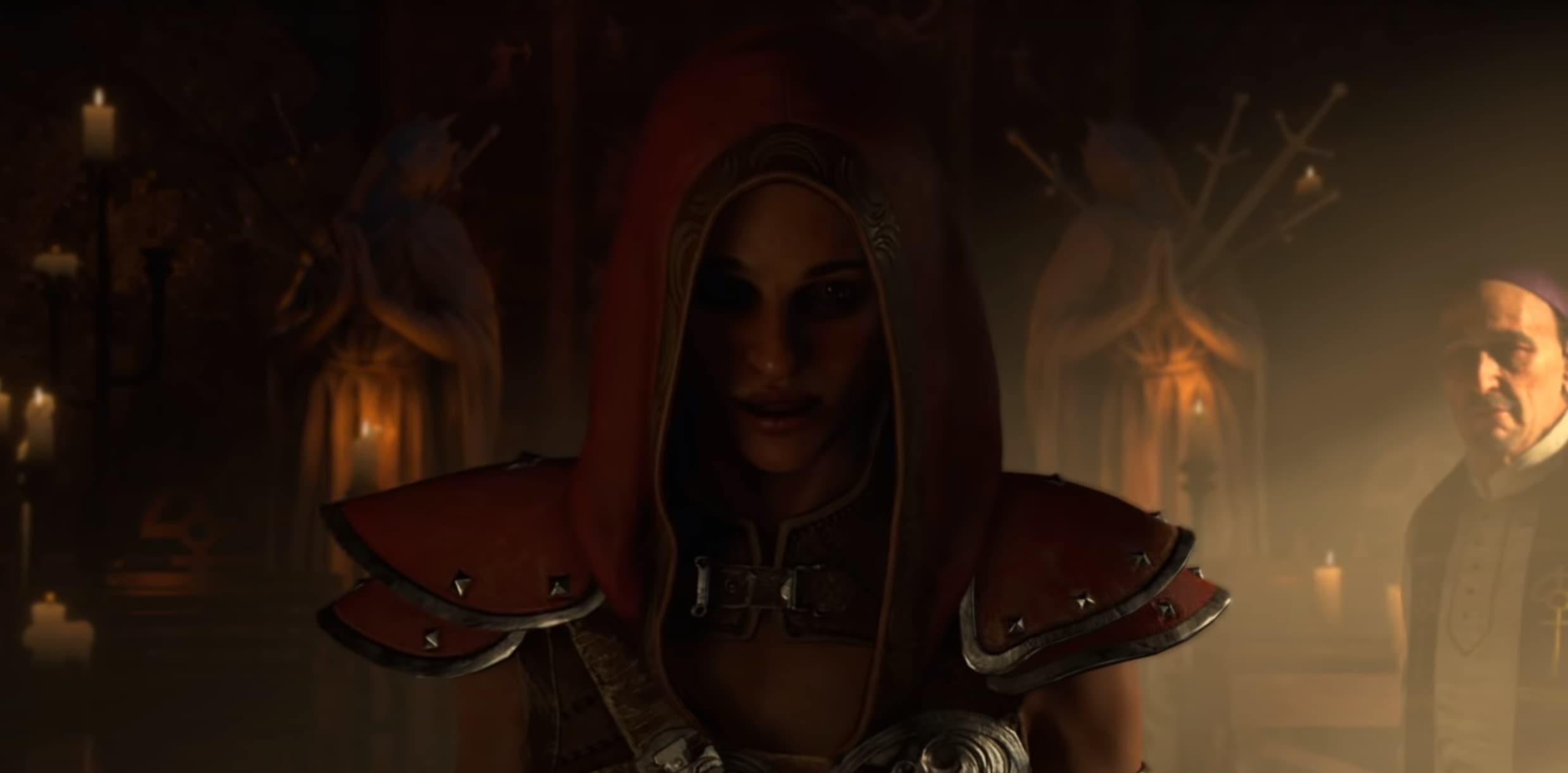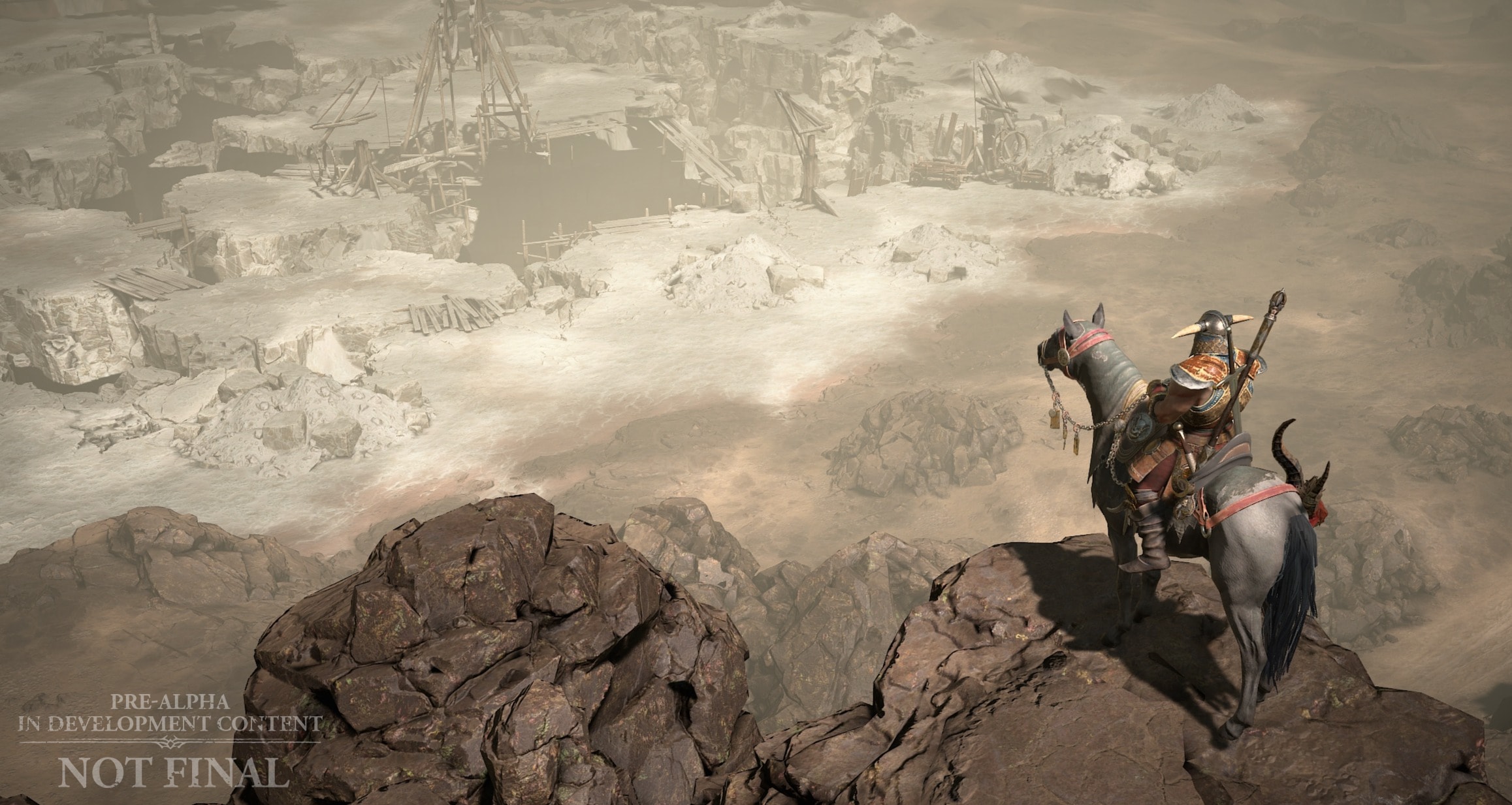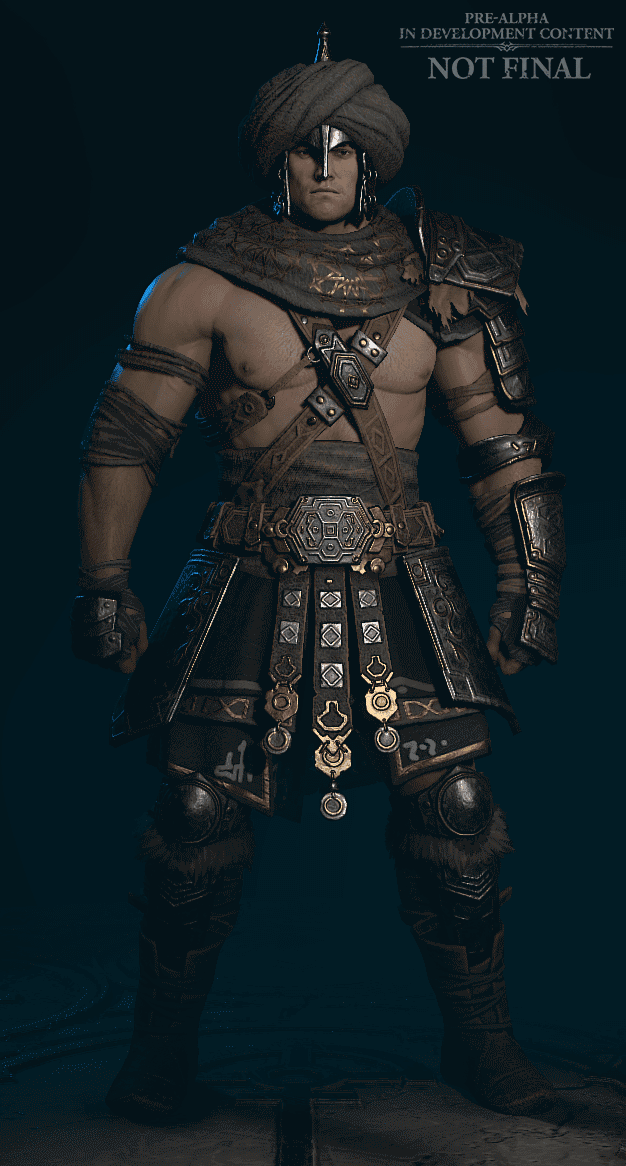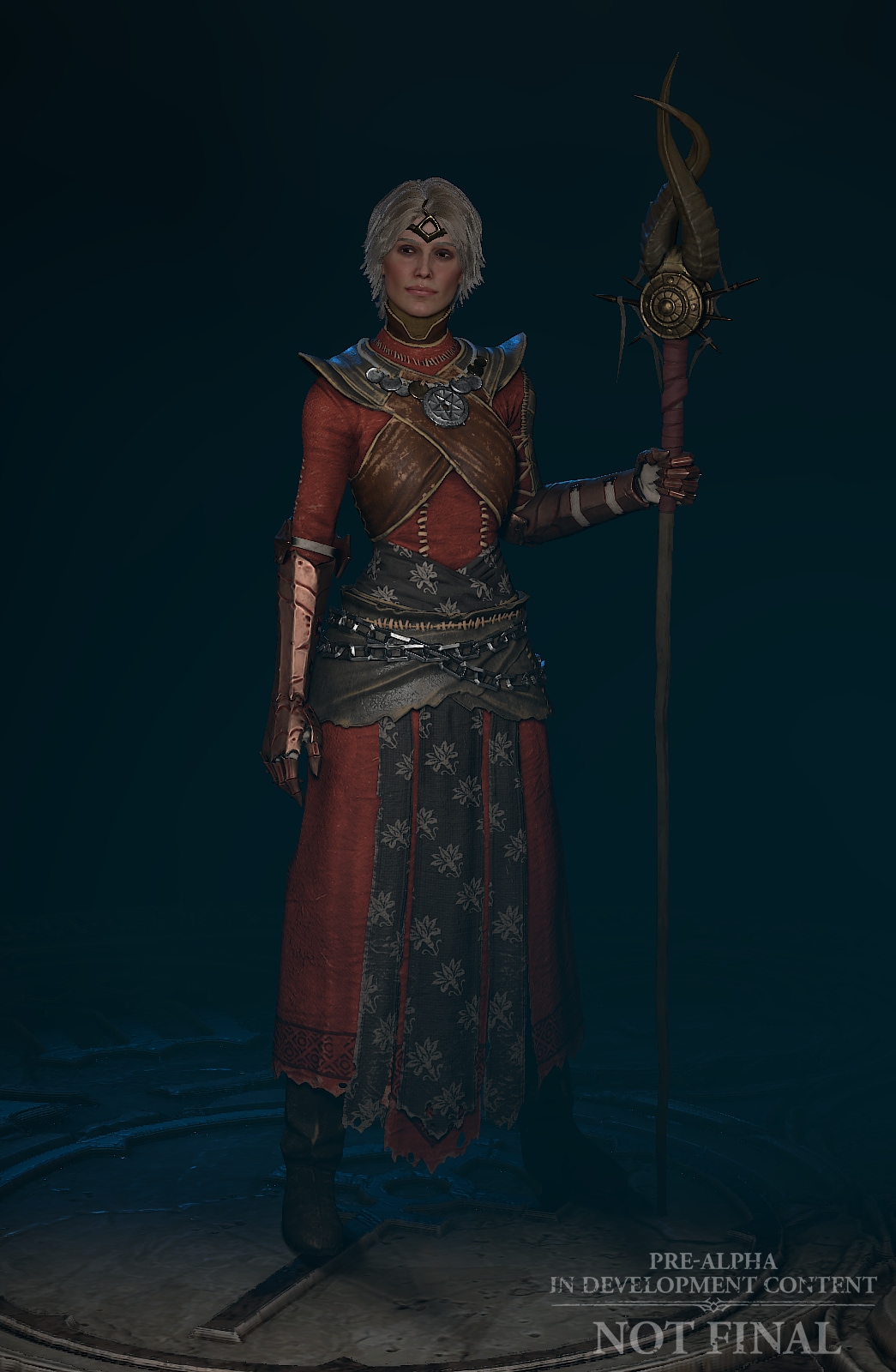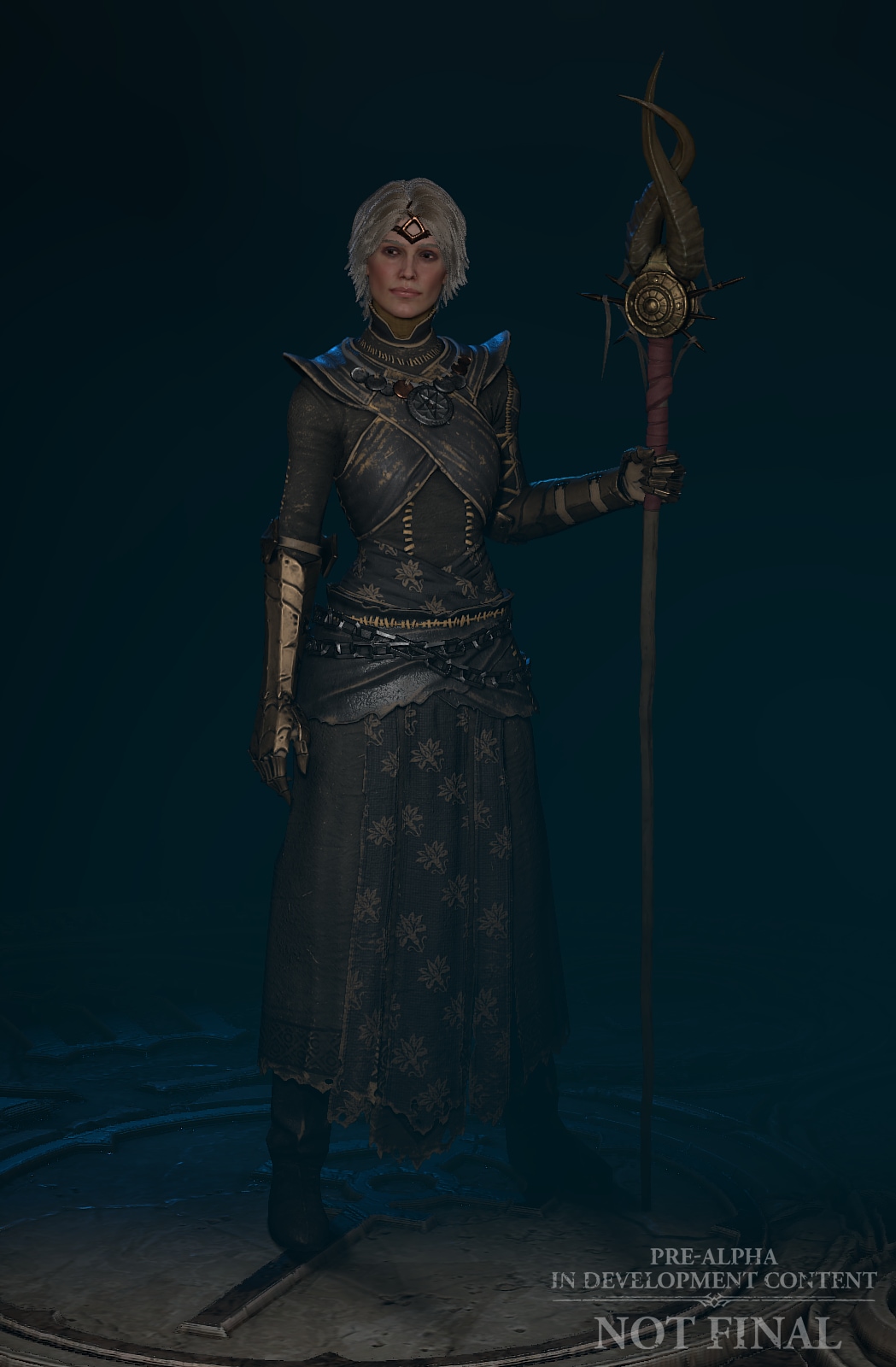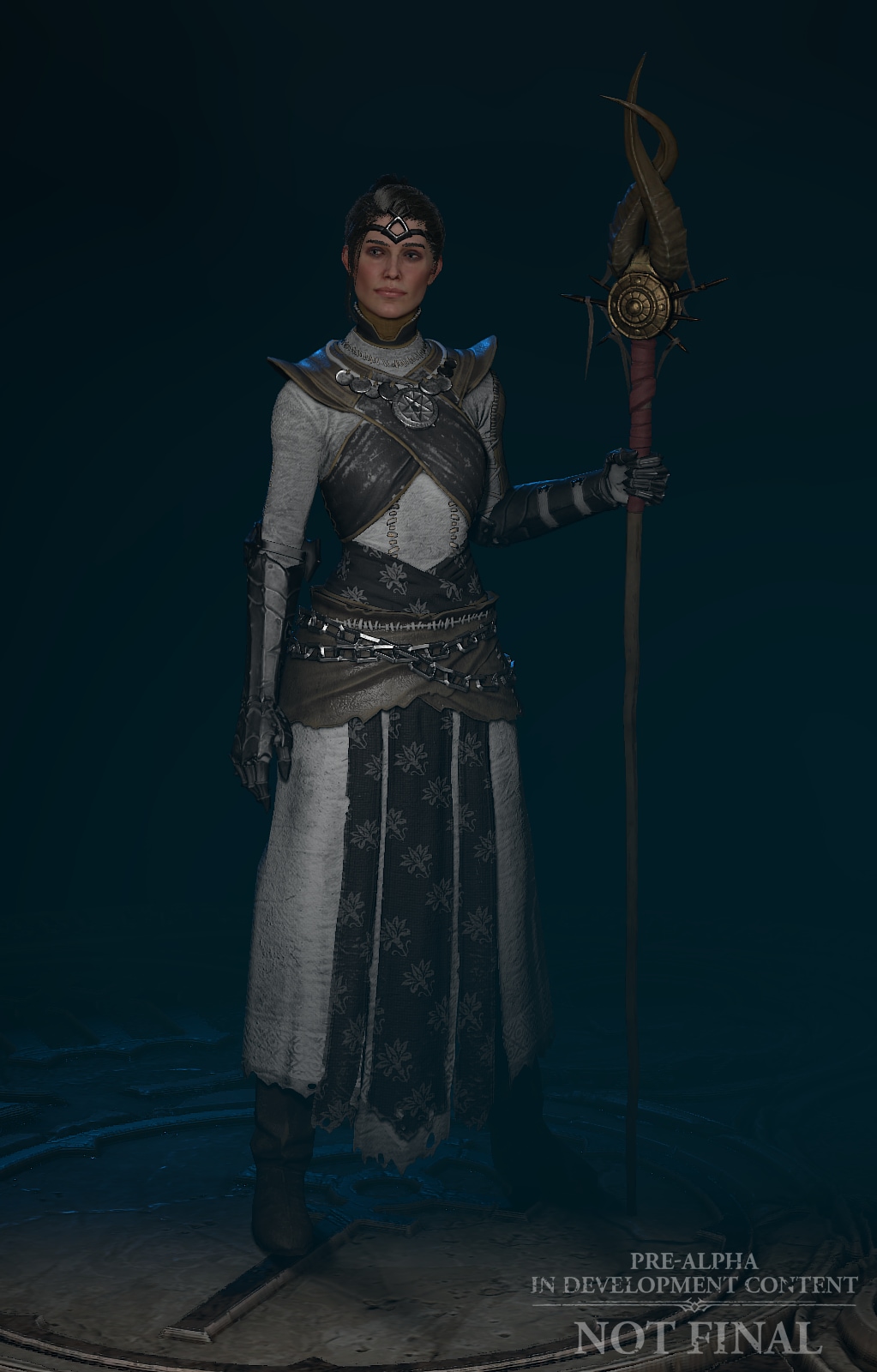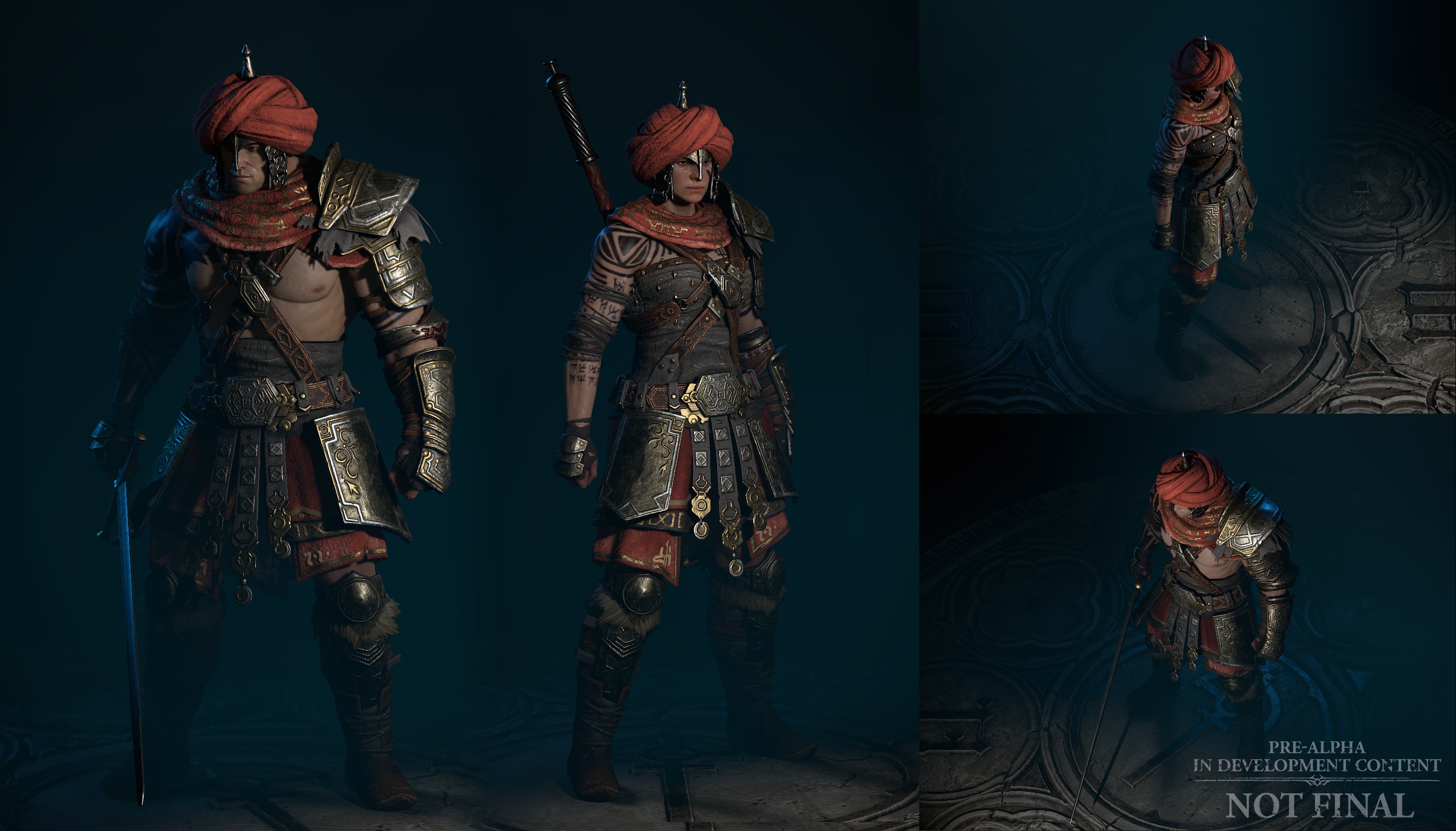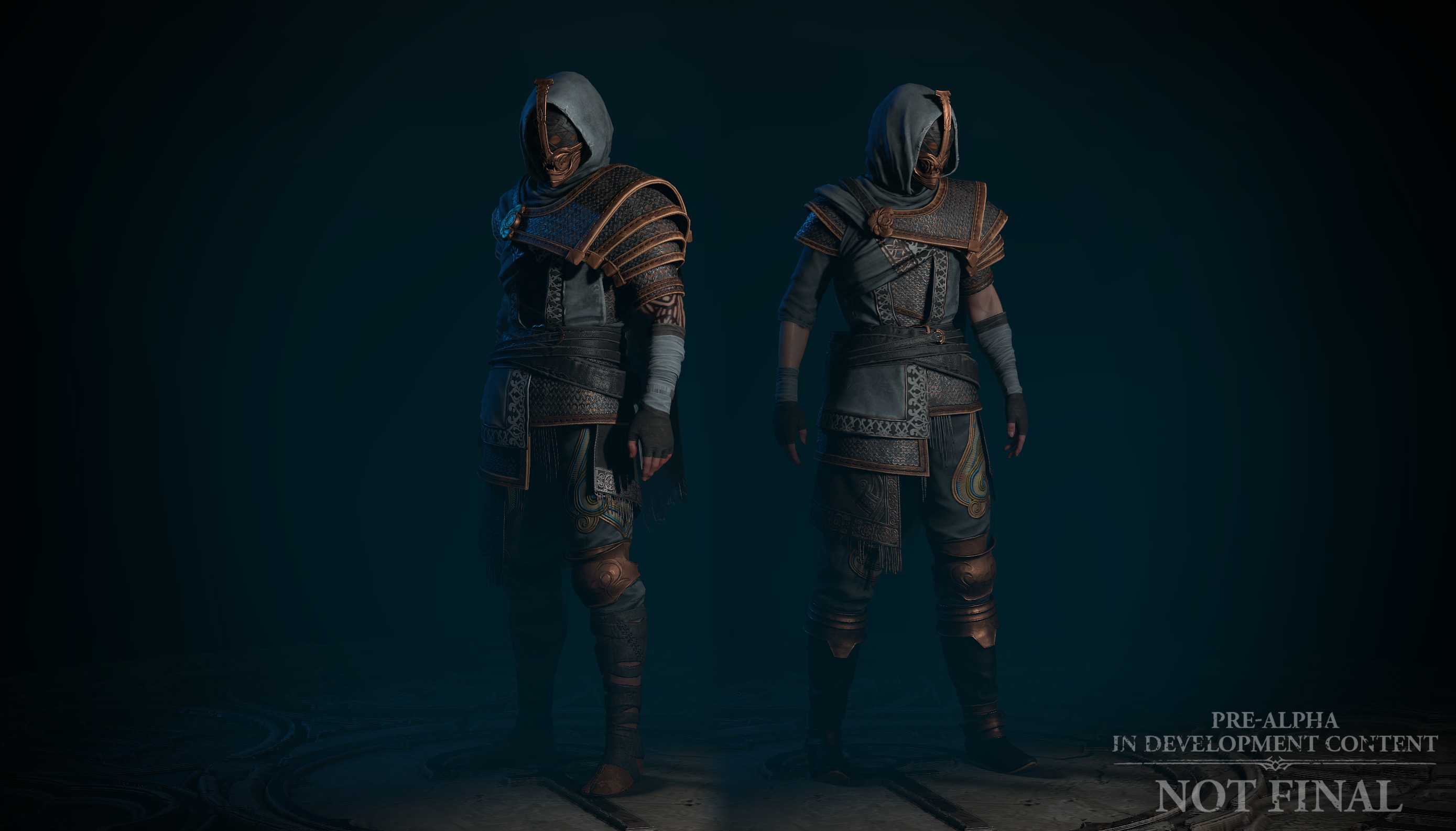「ディアブロ IV」四半期アップデート – 2021年6月
目次
- イントロ
- アートディレクター、John Mueller
- リード・キャラクターアーティスト、Arnaud Kotelnikoff
- キャラクター担当アソシエイト・アートディレクター、Nick Chilano
皆さんこんにちは。最新の「ディアブロ IV」四半期アップデートをお届けいたします。BlizzConlineではローグクラスの発表をお楽しみいただけたでしょうか。ローグをクラスとして作り上げ、オープンワールド動画を制作して皆さんと共有し、反応を得られたことは、私たちにとって素晴らしい体験でした。加えて、「ディアブロ イモータル」や最新の「ディアブロ II リザレクテッド」と並行して(いずれも個人的に皆さんとプレイできることが楽しみですが)、より大きな「ディアブロ」ファミリーの一部としてアップデートを共有できたことは特筆すべきことでした。
さっそくブログの本題である、開発中の様々な要素に焦点を当てていきましょう。本日の主題はプレイヤーキャラクター、モンスター、仲間などの「ディアブロ IV」のキャラクターアートです。
アートはディアブロを… 言わば「ディアブロ」たらしめる重要な要素です。例えば、シリーズを象徴するランダム化されたダンジョンは、角を曲がるたびにぞっとするようなディテールをプレイヤーに見せつけてくれるあの不気味なライティングがなければ「ディアブロ」らしくはならないでしょう。戦闘も、精緻に組み立てられたアニメーションとエフェクトで呪文や能力が活き活きと響くからこそ、感情をかき立ててくれます。そして、アイテムの良し悪しはステータスで決まるものかもしれませんが、開発者は装備を製作するとき、純粋にその見た目に心を躍らせている、というところもあります。
キャラクターアートも、クラスとモンスターという「ディアブロ」の主要要素2つに関わるものであり、他の部分と同様に重要なものと言えます。各クラスの外見と雰囲気は常に「ディアブロ」らしさを作る秘訣の一つです。どのクラスも一目見ればそれとわかり、強い個性が宿っています。「ディアブロ IV」はシリーズ史上最大のカスタマイズオプションが用意されています。特定の見た目を手に入れるのはより難しわけですが、トライする価値は十分にあるでしょう。皆さんのバーバリアンは他のプレイヤーのバーバリアンとは全然違う見た目でも、間違いなくバーバリアンらしく感じられるはずです。モンスターに関しては、新しい敵を作り出すとともに、旧作に登場したあらゆる悪の中から選ばれた「定番」をアップデートすることに注力しつつ、新たなプロセスやテクノロジーをフル活用しました。
このプロセス全体を皆さんにわかりやすく説明するため、続きはアートディレクターのJohn Muellerと彼のチームに任せたいと思います。
四半期アップデートをお楽しみいただければ幸いです。ご意見やご感想をお待ちしています!いつものことですが、皆さんが知りたいと思っているトピックについてお聞かせください。これから年末にかけてサウンドデザインやエンドゲームのシステムについても詳しくお話ししていきますので、ぜひ最新情報をお見逃しなく。
ありがとうございました。それでは次回をお楽しみに!
「ディアブロ IV」ゲームディレクター
Luis Barriga
アートディレクター
John Mueller
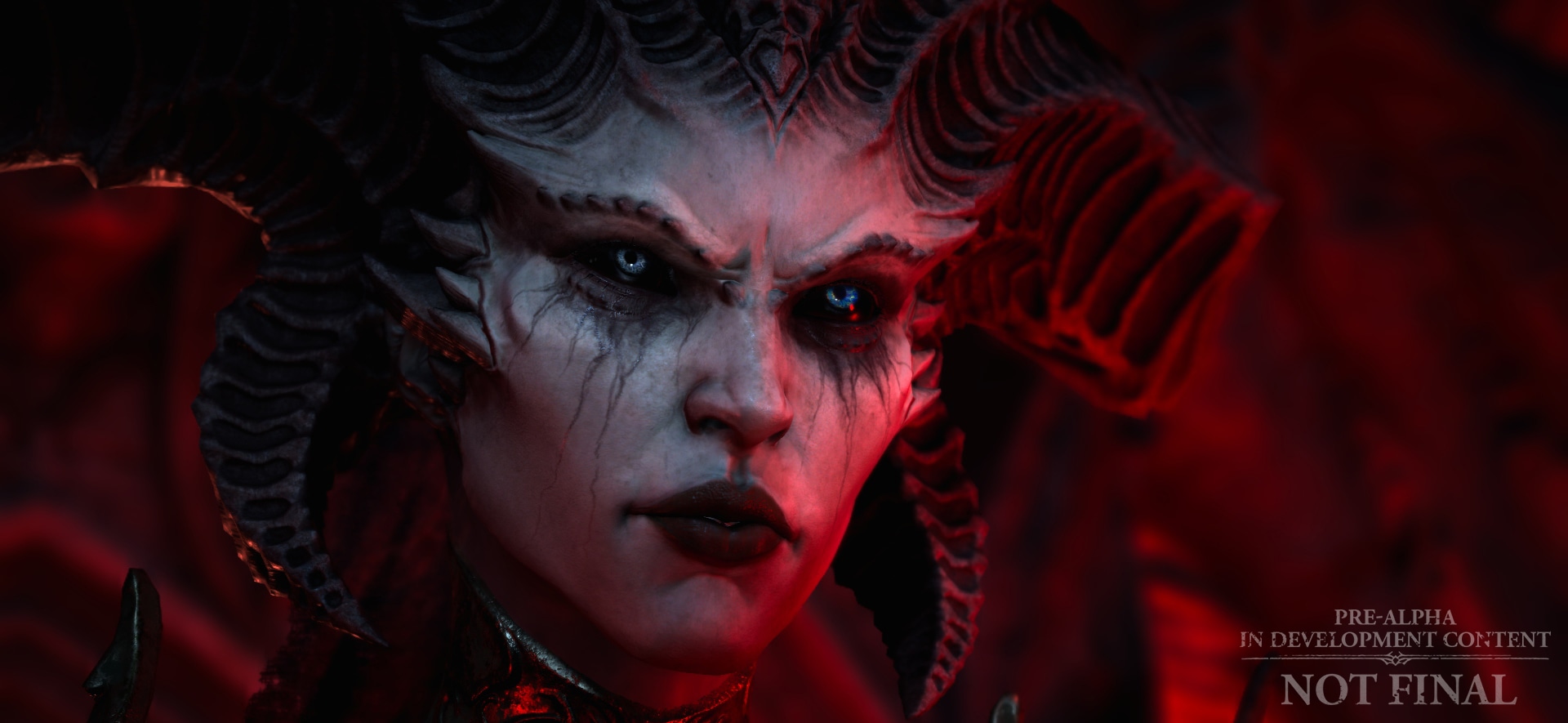
地獄から現れたお馴染みの魔性の美女、リリス!これは「ディアブロ IV」のゲームエンジンで描画されたゲーム内動画のキャプチャ画像です。「ディアブロ IV」では、このレベルの緻密な描画が主要なNPCやクラス、モンスターの描画の標準となっています。
皆さん、こんにちは!
「ディアブロ IV」のキャラクターアートの詳細をお伝えできるということで、楽しみです!私たちのチームにとってはとても嬉しいトピックです。というのも、「ディアブロ III」から非常に多くの変化があったからです。リード・キャラクターアーティストのArnaud Kotelnikofとキャラクター担当アソシエイト・アートディレクターのNick Chilanoからお話しさせていただきます。チームの2人が、ここで初めて明かされる、開発中のキャラクターアートの素晴らしいビジュアルをたくさん見せてくれるでしょう。今回はまだ開発中のコンテンツが多数登場しますが、私たちの狙いは、コンテンツを早期にお見せすることで、開発の方向性について知ってもらうことにあります。但し書きの類はそれほど多くはありません。現時点で完成している内容は皆さんが実際にゲーム内で目にするものにかなり近くなっていると思います。
キャラクターアートの開発に関しては、かなり大きな紆余曲折を経ています。それでは幕を開けて覗いてみましょう!まずは、私たちの素晴らしいキャラクターアートチーム、エンジニアリングチーム、アニメーター、ライティングアーティスト、そしてテクニカルアーティストたちに感謝の気持ちを伝えたいと思います。彼らがいなければ、これらのアートワークは実現しませんでした!
開発の初期を振り返ると、私たちの最高レベルの目標は、最新のツールやテクニックを用いながらも「ディアブロ IV」のキャラクターをできるだけアーティスティックに、手描きの感覚に近づけることにありました。時を経て、達成できると見定めたその野望は、実際に今皆さんがご覧になっているものへと進化していったのです。私たちは最新のツールや技術を使うつもりでした。ですが、リアリズムに傾倒しすぎて、Blizzard作品の基本とも言えるあの手描きの感触が失われることについては懸念がありました。ツールや技術の処理が原因で、キャラクターが画一的に見えたり通り一遍のものになってしまうことは避けたかったのです。私たちは単なるリアリズムではなく、素材や、キャラクターの外見という点でもリアルであることを追求しました。転換点は「ディアブロ III」の見事なプリレンダリングされたシネマティックだったように思います。私たちはそれが非常に気に入り、キャラクターを作る上での基礎に適していると感じました。その動画の温かみをリアルタイムのゲーム環境で再現できればよいのだと感じました。野心的な目標ではあるものの、可能だと考えたのです。もちろんこれは、今日見ている結果を達成するためにチームが交わした何千もの会話の概略に過ぎません。それでも、ここに至るまでの過程で、誰一人としてチームの限界に触れなかったことには大きな意味があります。やるべきではない、無理だ、できない、などの言葉は一切出ませんでした。全員がやろうと言ったのです。たとえそれが一からやり直したり、作ったものを破棄したりする場合でもです。全員が力を出し切り、最高の仕事をしてくれました。これはBlizzardが他に類のない所以のひとつだと思います。全員が「そうしよう、そのためには…」と言い、「ダメだ、なぜなら…」とは言わないのです。Blizzardで働いていてそこが素晴らしいところだと感じます。
クオリティに対する無類の集中力と献身をもって、私たちは今日自分たちが立っている場所へたどり着くまで長く曲がりくねった道筋をとだりました。その試練の過程で、レンダリングエンジンやオーサリングツールを完全に再構築する必要に迫られました。アーティストやツールエンジニア、リギングスペシャリストやサーフェスエキスパートからなる世界レベルのキャラクターチームを作る必要がありました。それは完全なオーバーホールでした。
私たちはディテールや、皮膚などの複雑な表面のサーフェシング、布のシミュレーション、髪、毛皮、金属、さらには目のハイライトや細く垂れる汗に至るまで、この水準に持ってくるために大幅な改良を行いました。私たちは「ディアブロ」で初となる幅広いキャラクターカスタマイズシステムを作り上げましたが、必要となる技術的な改良は気力を挫くほどの量でした。なぜなら、こうしたソリューションは特定のキャラクターでのみ成立すればよいのではなく、何百ものコンポーネント化されたアーマーセットや様々な体格のタイプ、何十種類もの個性的な顔、そして5つの初期クラスによって完全に異なるアートのそれぞれで実行可能でなければならないからです。これは私たちのチームが取り組むべきまったく新しいチャレンジでした。
今になってやっと(困難な仕事が終わりパイプラインが問題なく稼働しているため)そのすべては報われたと言うことができます。皆さんも(実際にプレイしたとき)このことに同意してくださるなら幸いです。キャラクターの見た目が真にサンクチュアリの世界の冒険を引き立て、物語や装備、そして皆さんの目に映るサンクチュアリのキャラクターがより良いものとなり、体験全体が楽しめるものとなれば何よりです。
特に、私たちが装備やキャラクターに注いだ愛情と心遣いを皆さんが感じてくだされば、と思います。「私だけの最高のバーバリアン」といったファンタジーが自分だけのものではなくなるわけです。今回この成果を皆さんにお届けできて嬉しく思います!
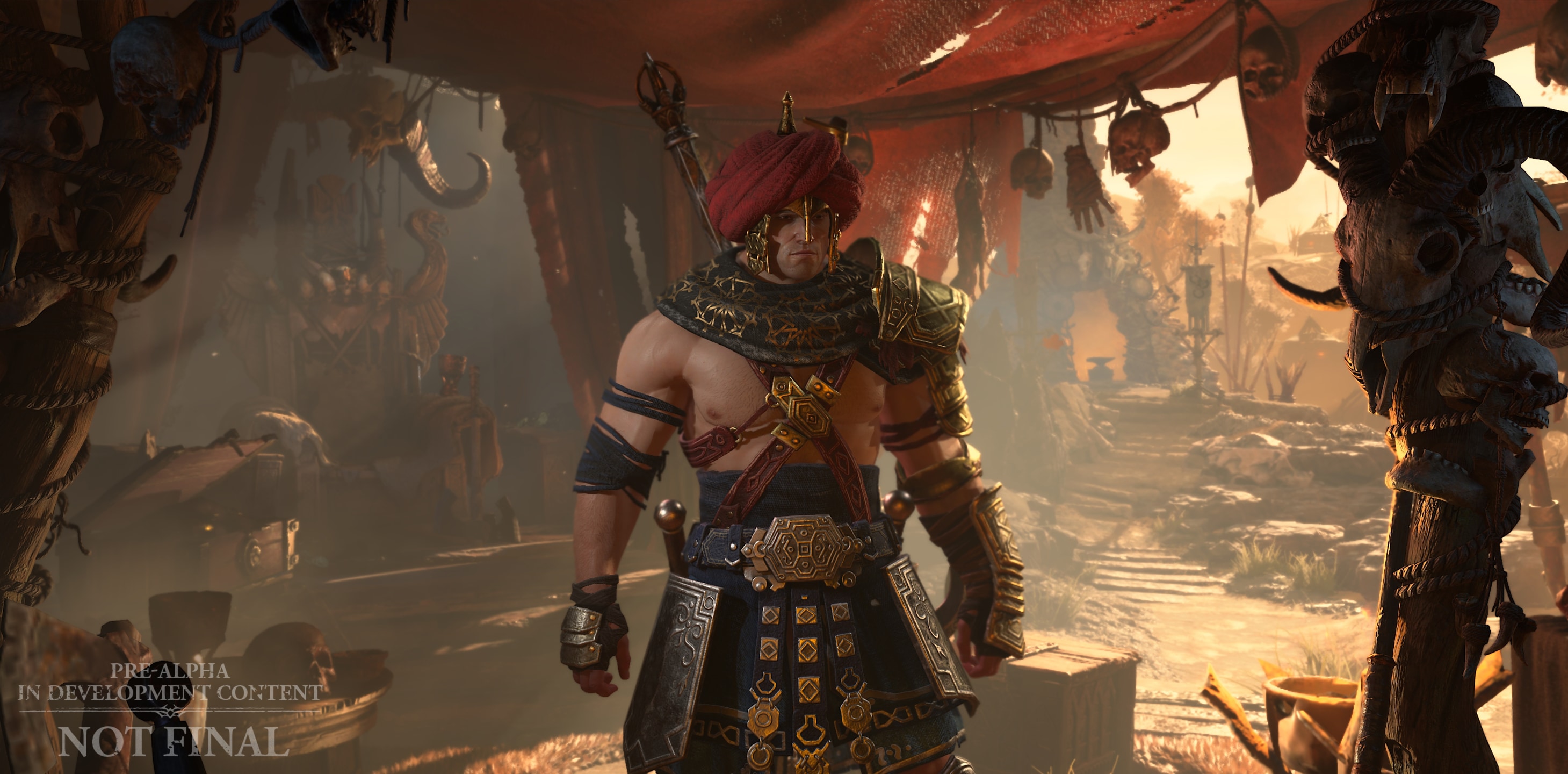
「根城のシーン」とチーム内で呼んでいる場面です。新しいワードローブシステムでは、プレイヤーはここでキャラクターの見た目をカスタマイズし、何百ものクラス固有のアーマーコンポーネントをミックス&マッチングして、カスタムカラーパレットで自分のキャラクターを最もよく表現できる、そのクラスの理想形を作り上げることができます。
私たちがキャラクターアート開発のパイプラインに行った投資がもたらしたメリットの一つは、自分たちのエンジンで、ゲームモデルを使った物語のカットシーンのほとんどを作れるようになったことです。過去の「ディアブロ」作品では、高解像度のシネマティックはすべてプリレンダリングされた映像でした。Blizzard Animationが手掛ける素晴らしい映像は今作にも登場しますが、プリレンダリングではなくゲームエンジンがリアルタイムでレンダリングした自キャラクターのアップ動画なども見ることができます。私たちは類のないBlizzard Animationチームと緊密に連携し、その知識をできる限り自分たちのプロセスに取り入れました。ローグのアナウンストレーラーは実に素晴らしいコラボレーションとなり、私たちの技術やツールのレベルを押し上げることにもつながりました。
これから、ゲーム内の内容をアップにしたとき、どれぐらい綺麗に見えるかを紹介したいと思います。ただし、「ディアブロ」ではすべてのものは等角投影法(斜め上からの俯瞰視点)に従っています。キャラクターの解像度やディテールのバランスはすべてゲームカメラでも再現される必要があります。注意深く見れば、私たちがアーマーの類には大きめのシェイプを用いて、解読し易さに影響する要素を減らそうとしていることに気付くでしょう。ディテールについては、解読し易さを維持しながら環境とも相性が良く、さらに現実的に見える"スイートスポット"を発見できたと思います。これは、私たちにとって最も重要な批評家であるプレイヤーの皆さんに、サンクチュアリのビジョンと世界をお見せする上で欠かせないことです。
達成できたこにはとても満足していますが、私たちはこれからもあらゆる機会で限界に挑み続けます。そしてBlizzardでは、ゲームのリリースはただの始まりに過ぎません。それでは、ここからはArnaudとNickとともに、キャラクターアートの奥深い世界をお楽しみください!
リード・キャラクターアーティスト
Arnaud Kotelnikoff
お読みいただき、ありがとうございます!私はキャラクターのカスタマイズと「ディアブロ IV」で開発したビジュアル面での改善について掘り下げたいと思います。
「ディアブロ IV」には過去の「ディアブロ」作品よりも奥深いキャラクターカスタマイズが用意されています。プレイヤーが変更できる要素として、顔、髪型、髭や眉などがあるほか、さらに装飾品(鼻ピアスやイヤリング)、化粧、そしてタトゥーやボディペイントといった体の装飾があります。また、キャラクターの皮膚や瞳、髪、髭や眉、体の装飾の色を変更することもできます。一部の要素はクラス固有のバックグラウンドを反映するためにそのクラスでしか使えなくなっていますが、多くはクラス共通で、膨大なミックスやマッチングの可能性があります。当のカスタマイズオプションの例は、このブログで紹介していきます。
さて、まずは私たちが直面した問題についてお話しさせていただきます。
ダークファンタジー×物理ベースレンダリング(PBR)
「ディアブロIV」の世界は現実に即したリアリティを持つ必要があり、それを達成するためには物理ベースレンダリング(PBR)のカラーバリューという根本原則に従う必要がありました。つまり、ゲーム内のモノは光が当たったときの見た目や挙動がリアルでなければならないということです。3Dアーティストにとっての挑戦は、コンセプトアートの色をPBRの数値に引き直すことでした。例えばPBRでは銀はとても明るく白に近いグレーですが、物質に反射があることでより暗い色に見えます。「ディアブロ IV」のキャラクターはすべてPBRの規則に従って、昼の光の下でも暗いダンジョンの中でも同じようによく見えるようにする必要がありました。
染料システムの拡張
プレイヤーがキャラクターの見た目をカスタマイズするためのツールは、プレイヤーとそのキャラクターとのつながり、ひいてはゲームとのつながりをより強くしてくれます。染料システムでは、アーマー類のカラーパレットを例えば銀色から金色へと変えたり、白い布を黒い布に変更したりすることが可能です。
アーマーのパーツは兜や胸当て、手袋、下衣、ブーツなどがありますが、その各々を染色できます。すべてのパーツを違う色にすることもできますし、すべてのパーツに同じ色を一気に適用することも可能です。
このシステムの実装で難しかったことは、金属のような素材はPBRに従えば金属以外の色をつけることができなかった点です。この問題を解消するため、私たちはアーマーの素材タイプを決定している部分にデータを追加して、皮、布、金属やその他どの素材にどの色が適用できるかを染料システムに指示するようにしました。結果として幅広い選択肢から染料を選べる、アーマーでありながら、「ディアブロ IV」の世界でリアルに見えるものができあがりました。
カメラのクローズアップ
私たちはキャラクターが等角投影法で描画されたときに見栄えが良く見やすくすることを目指していましたので、ゲームカメラは最優先事項の一つでした。それはキャラクター開発においてまず初めに留意されていたことでした。とは言っても、プレイヤーキャラクターはゲーム内で様々な方法で表示されます。例えばキャラクターカスタマイズ画面の中で、あるいはインベントリのペーパードールとして、ソーシャル画面で、そしてリアルタイム動画としても表示されます。特に動画ではしばしばズームインしてキャラクターをアップで見せる場面が、ゲームのほかの部分よりも多くなります。これをサポートするため、私たちはディテールマッピングと呼ばれるテクスチャのレイヤーを追加しています。ディテールマッピングとは小さな連続するテクスチャで、モノの表面に適用され、メインのテクスチャよりもシャープで細かい特徴を表現するためのものです。
「ディアブロ IV」のアーマーセットにはすべて2つの体型があります。こちらはバーバリアン用の細部に違いのある2種類のアーマーセットです。
こちらのサンプルでは異なる体型のローグが同じアーマーセットを着用しています。
以下は私たちのリアルタイムエンジンで録画したローグのスローモーション動画です。細部がはっきり見え、素材に対して光がどのように反射しているかがわかるかと思います。さらに、先ほどお話ししたカスタマイズ要素の一部も目に留まるはずです。ただしここに見られる環境は、モデラーがキャラクターを確認するために使用するテストシーンであり、こうしたアーマーの多くは開発段階のものであるため、今後変更や修正が行われる可能性があります。
こちらはまた別のバーバリアンのスローモーション動画です。こうしたアーマーは開発段階のものであり、今後変更や修正が行われる可能性があります。
これらはまだ「ディアブロ IV」で実装されるキャラクターカスタマイズのほんの一部です。チームは最高のクオリティをお届けすることに全力を注いでいます。実際の「ディアブロ IV」で、キャラクターカスタマイズのために用意されたすべてのオプションを楽しんでいただければと思います。
キャラクター担当アソシエイト・アートディレクター
Nick Chilano
皆さん、こんにちは。
今日は「ディアブロ IV」のモンスターを作るためのビジョンとプロセスをご紹介できるということで、大変光栄に思います。
モンスター作成を成功させるには様々な要素を組み合わせる必要がありますが、第一歩は、プレイヤーがそれを倒した時に満足感を得られるかどうかから始まります。つまり、モンスターにはゲームプレイにマッチしたビジュアルと、残虐/悪魔的な風味付けが求められるということです。モンスターは現実的には誰も見たことがない姿形でありながら、誰もが知っているもので、さらにそこに「ディアブロ」の絵筆で仕上げを加える必要がありました。この「ディアブロ」の絵筆によって、一層のディテールと、ゲームプレイのニーズの理解、アート性とあの悪魔的な「ディアブロ」テーマが、すべてのモンスターに描き足されるわけです。
ビジュアルデザインとゲームプレイの意図
私にとっては、すべては目標から始まります。大抵は、このモンスターは何をして、プレイヤーにどのような体験をもたらすかをデザインすることから目標が導き出されます。ゲーム作りとはコラボレーションでもあります。ビジュアルコンセプトがアイデアを後押しすることもありますが、紙に描かれたデザインだけで十分な場合もあります。
ブラッド・ビショップ
ブラッド・ビショップのゲームデザイン目標は、直接ダメージを与える魔法の使い手にして、プレイヤー侵入不可の範囲ダメージの爆弾を作り出す、スペルキャスターを作ることでした。ビジュアルに関しては、吸血鬼の系統で魔法を使う高レベルのボス、ということが求められていました。また、血の魔術の機能としてハート型を強調したいということも意識されていました。こうした発想が自然とまとまって、爆発する血の塊が血管から作り出されるアイデアが生まれ、それによってデザイン上求められた範囲ダメージを表現することになりました。ですので、剥き出しの脈打つ心臓はビジュアル上の必然的な選択でした。それで、生きた心臓の脈動、血管を流れる血、そして血をベースにしたVFXを組み合わせることでチーム共通の目標を達成しようということになりました。ゲームデザインのニーズを、ビジュアル上の「ディアブロ」らしさを出しつつ満たすことができました。
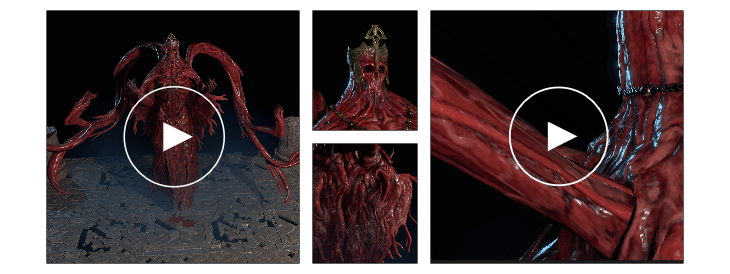
スケルトン・ロード
先程とプロセスは似たようなものですが、スケルトン・ロードには叩き台となるビジュアルコンセプトがありました。
アンデッドのスケルトン・ロードは骨と体のパーツが腱や血でつながれた姿で描かれ、私たちがゲームに合っていると感じたビジュアルを体現しています。そのため、あるデザインリードがこのキャラクターをベースにして戦闘を作りたいと発案しました。デザインチームは骨のビジュアルや骸骨の召喚、敵の進路を塞ぐ骨の壁、そして巨大な杖を駆使した独特な戦闘を作り上げました。特にこの杖は、スケルトン・ロードが地面に叩きつけて爆発する骨の欠片が降り注ぐ、という攻撃の一部にもなっています。これは、最初にアートが作られたものの、デザインチームがそのイメージを膨らませて面白みのある戦闘場面を作り出したという一例です。
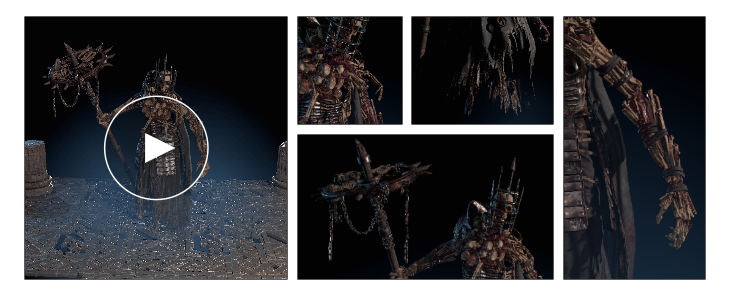
ゲームに適したアートのディテール
アセットについて、私たちは2つの視点から考える必要があります。それはゲームカメラと、キャラクターの全身像を寄りで捉えるボディサイズカメラです。つまり、私たちは全体的な形とより細かい二次的・三次的ディテールについて何が重要なポイントで、何がそういった要素を支えているかを理解する必要があります。
アーティスティックなディテールの水準を保つことは挑戦の連続です。ディテールはゲーム内できちんと読み取れる必要があり、色にはまとまりが必要ですし、形がわかりやすいと同時に、パフォーマンスや動きに適したものでなければなりません。等角投影法のカメラでモンスターが魅力的に見えると同時に、アップでも素晴らしいディテールを表現するには、その理解が不可欠です。
膨れあがった死体を食らいながら子蜘蛛を生み出すこの蜘蛛は、素晴らしいビジュアルデザインでした。
いかにも蜘蛛らしい脚と胸部で、すぐにそれとわかります。細い脚が太い体につながっているところは、シルエットをまとめる上でいいバランスになったと思います。蜘蛛の高彩度の赤は体の目立たない地色によく映えて、このモンスターが画面に登場した瞬間に目につきます。より詳しく見ていくと、蜘蛛の膨らんだ体には鮮明なハイライトが施され、引きちぎられた肉片や膿疱も表現されています。このようにゲームカメラを寄せて見るとグロテスクなディテールが判明するのは、形態と色が明確に分類されているお陰なのです。
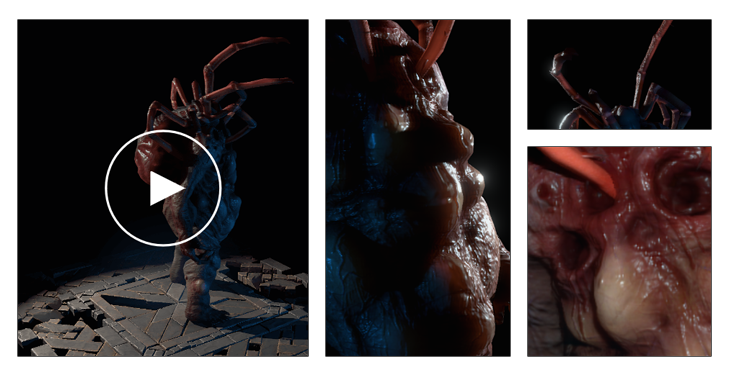
こちらのサキュバスも、興味深く明確なビジュアルを引き出した例です。詳細なディテールはゲームカメラの邪魔にならないものでありながら、ビジュアルの水準を押し上げています。
ゲームカメラではお馴染みのシルエットを見ることができます。有翼のデーモンが空中を舞いながら獲物を魅了し、離れた場所から魔法を撃ってくる姿です。詳細に見ると、布の質感や透明感のある翼の皮膚、そして衣装についた金色の金具や縫い目、刺繍などが明らかになってきます。さらに、翼は頭の下から生えていることもわかります。こうしたディテールは、異なるカメラで見たときには情報過多とならず、接近したときにだけ見えるものです。
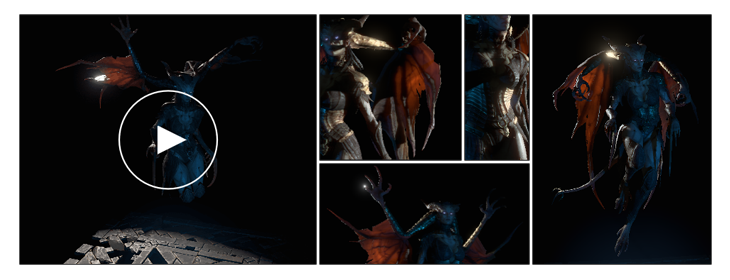
現代的なパイプライン
こうしたことを達成するためには、素晴らしくも不気味なこれらの創造物を具現化するプロセスと技術が必要でした。そのため、私たちは世界レベルのチームを結成して「ディアブロ」シリーズの水準をさらに引き上げる品質のモンスターやデーモンを作り上げました。
PBRにより、写実的でなおかつゲーム世界のライティングを忠実に反映する表面や素材を作ることが可能になりました。皮はより皮らしく、金属は金属らしく、対照的に生物の表面は生き物らしく柔らかで肉感のあるビジュアルを作り出すことができました。
この騎士は頭から爪先まで金属と布に覆われていますが、それぞれの素材が光源に対して異なる反射を見せます。素晴らしいディテールや、実際にありそうな、硬質な表面の素材が破損している部分なども見て取ることができます。このディテールがあるからこそ、誰もが知り理解できる世界を作り出すことができるのです。金属の小片が作り出すスケイルアーマーの細かいパターンから、打ち出し板金の大きな平面、そして金の縁飾りまで、違いは容易に目視できます。
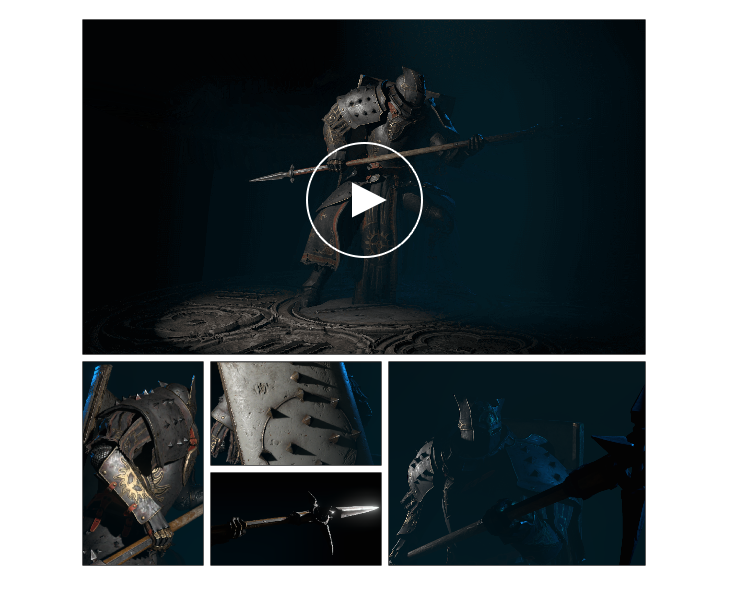
私たちのエンジンは、生体の表面も正確に表現することができます。毛皮も骨も、肉も血も、すべて正確に描画され、光源に忠実な反射を表現しています。何と言っても本作は「ディアブロ」作品であり、こうした素材の表現が重要であることは私たちの誰もが理解していました。
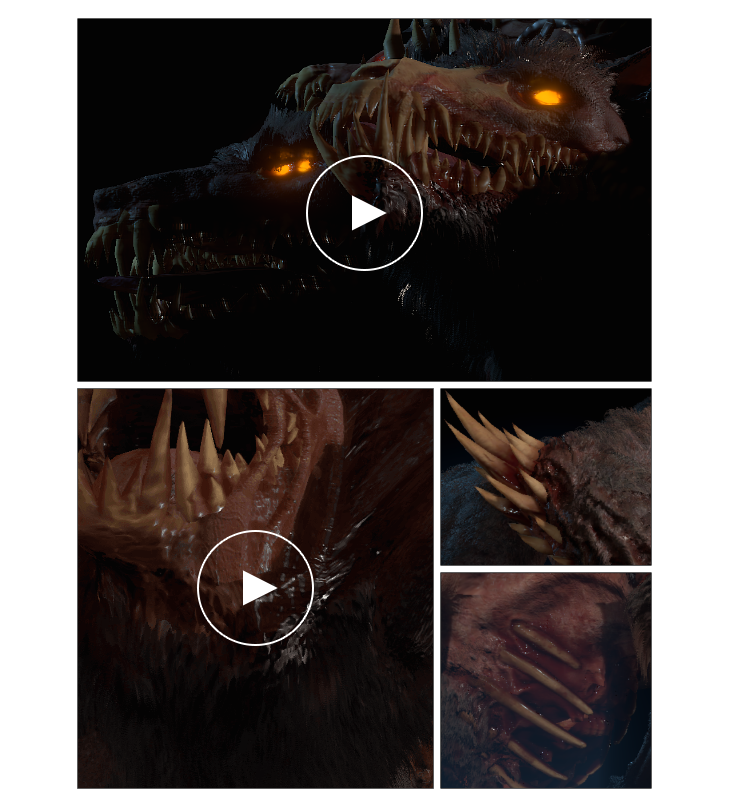
これで「ディアブロ IV」のモンスターの短い解説は終わりますが、私たちが恐怖や嫌悪感を引き出したり、「ディアブロ」らしいスタイルで敵を倒すときの高揚感を作り出したり、プレイヤーから多様な感情を引き出せるような敵やモンスター、魔物などを作り上げることを心から楽しんでいる様子は伝わったでしょうか。
最後にお伝えしたいことが一つあります。開発者として連日ただゲームを作っていると、日々画面に映る作品は、自分たちが好きな時に特権的に目にすることのできるもののはずなのですが、そうしたものを鑑賞する時間を持つことはおろそかになりがちです。だからこそ、こうしたブログを通して皆さんに向けて進捗や、どのようなプロセスを踏んでいるかをお伝えできて光栄です。私たちの長い旅路を振り返るよい機会になりますし、自分が作ったアートや仲間の作品を楽しむこともできます。今回お見せした内容を気に入っていただければ幸いです。重ねてとなりますが、お使いのプラットフォームでぜひコメントをお寄せください。私たちはコミュニティからのフィードバックを楽しみにしています。皆さんのために作品を作れることを光栄に思っていますし、遊んでもらえる日を楽しみにしています!
ここまでお読みいただき、ありがとうございました。次の四半期ブログもどうぞお楽しみに!
- 「ディアブロ IV」チーム
